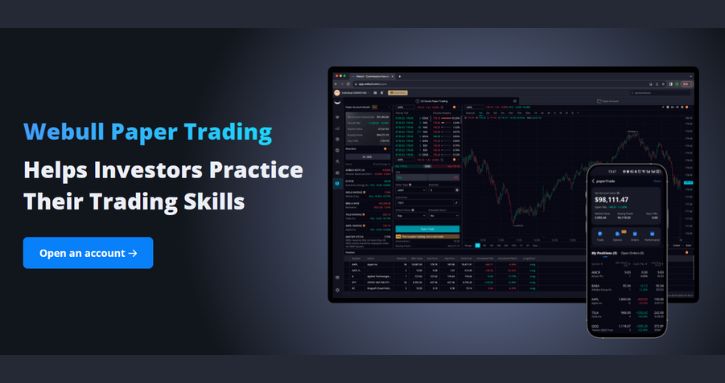How to Use Webull for Paper Trading: The Ins and Outs
When you’re learning to trade or want to test new strategies without risking real money, Webull for paper trading is the way to go. Webull, a popular investment platform, offers a free paper trading feature that lets you simulate trading in the real market.
Paper trading is like a flight simulator for traders. It mimics the real market using virtual money, so you can practice buying and selling stocks without any financial risk. It’s perfect for beginners to learn the ropes, and experienced traders can use it to test their strategies before applying them with real funds.

Getting Started with Paper Trading on Webull
To begin paper trading on Webull, you need to have the Webull app installed on your phone or tablet. Here’s what you need to do:
- Sign Up or Log In: Sign up for a new account using this Webull referral link if you don’t have one. If you’re already a Webull user, just log in.
- Accessing Paper Trading: Look for the “Paper Trading” option within the app menu. This will take you to the paper trading environment.
- Receive Your Paper Money: Webull provides you with a virtual cash balance to start trading. The amount may vary, but it’s usually a sizeable sum to practice with different investment strategies.
Making Your First Paper Trade
Now that you have your virtual cash, it’s time to dive into trading. Here’s how you can place your first paper trade:
1. Choose a Stock: Use the search bar to find a stock you’re interested in. You can search by the company name or ticker symbol.
2. Analyze the Stock: Tap on the stock to see its details. You’ll find charts, news, and data to help make your decision.
3. Place a Trade: Once you’re ready, click on the “Trade” button.
- Select whether you want to buy or sell.
- Enter the number of shares.
- Choose the order type (market order, limit order, etc.).
- Review your order to make sure everything is correct.
- Hit the “Paper Trade” button to execute the trade.
4. Monitor Your Positions: After placing trades, keep an eye on how they perform. You can check your open positions within the paper trading section.
Experiment with Different Strategies
With Webull for paper trading, users have a unique opportunity to explore a variety of trading strategies in a completely risk-free environment. users have a unique opportunity to explore a variety of trading strategies in a completely risk-free environment.
One such strategy, day trading, is especially suited for those who enjoy the pace and potential of the stock market’s daily fluctuations. Involving the purchase and sale of stocks within the same trading day, day trading challenges you to profit from small price changes in stocks that are known for their liquidity and frequent price movement.
If you’re someone who prefers a slightly slower pace, swing trading might be more to your taste. This strategy requires you to hold onto stocks for a period that can range from several days to a few weeks, with the goal of benefiting from expected shifts in the market, whether they be up or down. It’s a method that calls for a keen eye on market trends and a bit of patience.
For those with an even longer-term outlook, there’s long-term investing, which is all about building a diverse portfolio with the intention of holding onto stocks for an extended period—think months or even years. This strategy hinges on the belief that, despite short-term market volatility, the value of well-chosen investments will increase over time.
And for those who are analytically inclined, paper trading on Webull presents the perfect chance to put technical analysis to the test. By using the platform’s suite of charting tools, you can experiment with various technical analysis techniques, applying them to real-market data without any financial risk. Whether you’re observing chart patterns, studying indicators, or identifying trends, paper trading allows you to see how your analyses play out over time, giving you valuable insights into the effectiveness of these techniques in live trading scenarios.
Use Advanced Order Types
When you’re paper trading on Webull, don’t just stick to the simple buy and sell orders. Try out some of the more complex order types to get better at trading.
With limit orders, you can set the exact price you want to buy or sell a stock at. This means you can name your price and wait to see if the market matches it. Then there are stop-loss orders, these are like setting up a safety line that automatically sells your stock if the price drops to the level you’ve set, helping you cut your losses. Another neat type is the stop-limit order, which is a mix of the two. It starts with a stop price that, once reached, changes into a limit order, making sure your stock is sold at a certain price.
Using these different orders can make your paper trading more like the real thing and can teach you how to use them in live trading later on.
Tracking Your Performance
When you’re paper trading on Webull, it’s a good idea to keep an eye on how you’re doing. You should look back at your past trades every now and then to figure out what worked and what didn’t. Knowing when you made or lost money can teach you a lot and help you get better.
Webull has a special part of the app called the “Performance Tab” where you can see how you’re doing with your trades. It shows you things like how many trades you’re winning and losing, and other helpful information.
If you’re not doing as well as you want to, you can change how you trade. Try different ways of trading to see what gets you better results. This is how you can use what you learn from your past trades to do better in the future.
Learning from Paper Trading
Even though Webull for paper trading doesn’t involve real money, it’s still important to take it seriously if you want to really learn from it. Pretend the virtual money is your actual cash. This makes your practice more real, and you’ll act more like you would if it was your own money on the line. It’s also a good idea to write down what you do when you trade and why you do it.
Keeping track of your decisions can help you see what you’re doing well and what you might need to work on. Plus, don’t forget to keep up with the latest news and check out Webull’s own articles and updates. By staying on top of what’s happening in the markets, you’ll make your paper trading feel more like the real thing, which can be a big help when you’re ready to start trading for real.
Transition to Real Trading
After you’ve gained confidence and developed successful strategies through paper trading, you may be ready to start real trading. Remember, the emotions and risks associated with real trading can be different, so start small and continue to apply the lessons you’ve learned from paper trading.
Conclusion
Paper trading on Webull is a fantastic tool for traders at all levels. It allows you to practice in a real-world environment without the financial risk. Whether you’re a beginner learning the basics or an experienced trader optimizing your approach, Webull’s paper trading feature can help you refine your skills. Embrace this opportunity to experiment, learn, and grow as a trader.
